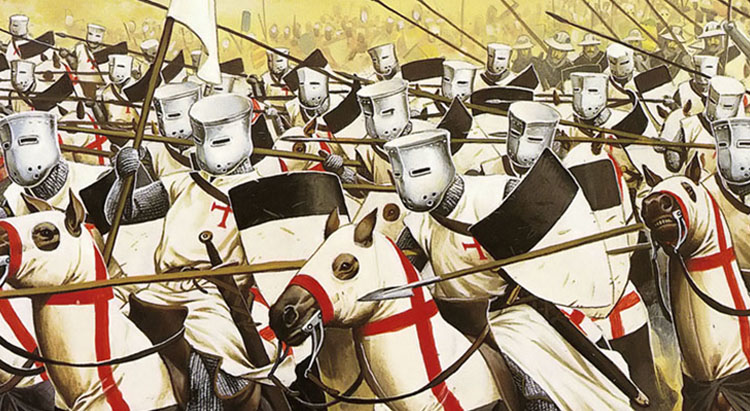On Friday October 13, 1307, the King of France, Philip IV the Fair, ordered all Templars in the kingdom to be arrested. The King, nicknamed the Iron King, had decided to put an end to the Knights Templar.
The Knights Templar was founded in Palestine in 1118. Hugues de Payns, a knight, launched this group of soldier-monks in Jerusalem. They initially lived in a wing of the Al-Aqsa Mosque (the former Hebrew Temple, which is now known as of the Temple of Jerusalem).
The Templars protected pilgrims traveling by road to the Holy Land. Thanks to donations from lords and the middle classes, who were worried about their survival during the journey, the soldier-monks quickly became rich.

An Army of Fearsome Soldiers
Recognizable by their long white coats adorned with a large red cross, the Templars represented an army of fearsome soldiers. Furthermore, their independence from the King of France made them untouchable. Remaining loyal to their own beliefs, they could be compared to mercenaries.
The French crown’s distrust of the Templars came from the fact that they represented a powerful army. In addition, the Knights Templar was at the head of a large fortune. To ensure their presence on the lands of Palestine, King Philip IV the Fair had to finance the Templars on an ongoing basis. As a result, the French Kingdom’s coffers were often empty. Unable to always give them money, Philip IV the Fair found himself in debt to the Knights Templar.
A Powerful Monastic Order
The prestigious nature of the soldier-monks, in their white cloaks bearing a red cross, was monumental for two centuries. They were loved by the French people and feared by enemies of the Church. However, this did not prevent the Muslims from countering them in the Holy Land, and then seizing Saint-Jean-d’Acre on May 28, 1291.
At the beginning of the 14th century, the Knights Templar still had a military force of some fifteen thousand men, despite being expelled from Palestine. Back in the Kingdom of France and loved by the French people, the Templars were on the verge of becoming a state within a state! The popularity of the Knights Templar and its soldier-monks was largely thanks to its donations and acts of generosity towards the most deprived in society.
The Templars in Europe
Although the Knights Templar had a significant presence on lands belonging to the King of France, the Templar commanderies also covered a good part of medieval Europe in what can only be likened to the span of a spider’s web. They housed soldier-monks who also had a charitable vocation, something which appealed greatly to people of modest means.
 King Philip the Fair was not as popular as the Templars. This represented a real threat to the supreme interests of the monarchy’s power.
King Philip the Fair was not as popular as the Templars. This represented a real threat to the supreme interests of the monarchy’s power.
To get rid of the Knights Templar once and for all, the King created false rumors about the depraved morals practiced by the soldier-monks.
Advised by his most faithful ministers, the Iron King secretly conjured up a plan to bring about the definitive fall of the Templars.
The unfolding drama on Friday October 13, 1307
Tired of seeing these knights with their long white cloaks, King Philip IV decided to do everything possible to make them disappear forever. The King urged the Pope to act against the Knights Templar. Without waiting for a possible investigation by the Vatican, for charges of heresy, the king’s disciples had all templar members arrested.
The Templars were accused of the most heinous of crimes, even being apprehended for denying Christ. On Friday October 13, 1307, all Templars in France were arrested. Following this cursed day, which was a veritable bloodbath, many people claimed that Friday the 13th brought about bad omens.
To put an end to the Templar threat to the monarchy, Nogaret, the king’s chief minister, sued the Templar members, and 54 of them were burned at the stake.
Interrogated under torture by royal commissioners, the Templars had to confess to acts they had never committed. As a result, the Templars were considered as forces of Evil.
 In order to not be seen as being disowned by the Kingdom of France, on November 22, 1307, the Pope ordered the arrest of all Templars in Christendom. Only Knights Templar members who managed to flee and blend into the crowd succeeded in saving themselves.
In order to not be seen as being disowned by the Kingdom of France, on November 22, 1307, the Pope ordered the arrest of all Templars in Christendom. Only Knights Templar members who managed to flee and blend into the crowd succeeded in saving themselves.
In 1312, the King of France obtained the definitive suppression of the Knights Templar from Pope Clement V. On March 19, 1314, Jacques de Molay, the Master of the Order of the Knights Templar, was burned alive at the stake.
 Before being set on fire, rumors suggested that Jacques de Molay cast a spell on the King of France and the Pope. He proclaimed aloud:
Before being set on fire, rumors suggested that Jacques de Molay cast a spell on the King of France and the Pope. He proclaimed aloud:
“Pope Clément and King Philip! Before one year, I summon you to appear before the tribunal of God to receive your just judgment! Cursed! Cursed! Cursed to the thirteenth generation of your races!”
Such was the curse proclaimed by Jacques de Molay, the last grand master of the Knights Templar.
The Iron King
With the Templar affair, King Philip IV the Fair demonstrated that he intended to follow his political interest, and not be a vassal of the Church. It was through his actions that King Philip became known as the “Iron King.” By taking the initiative to pursue the Knights Templar, the King of France only added credence to the myths surrounding Friday the 13th.
Mysteries surrounding the Knights Templar
The story of the Templars was one of the most mysterious of the Middle Ages! A veritable shock troop made up of seasoned soldiers, the soldier-monks were placed at the forefront of crusades. This militia, in the name of Christ and the Temple of Solomon in Jerusalem, also maintained a religious ideal. However, many questions still remain about the fortunes they accumulated over two centuries.